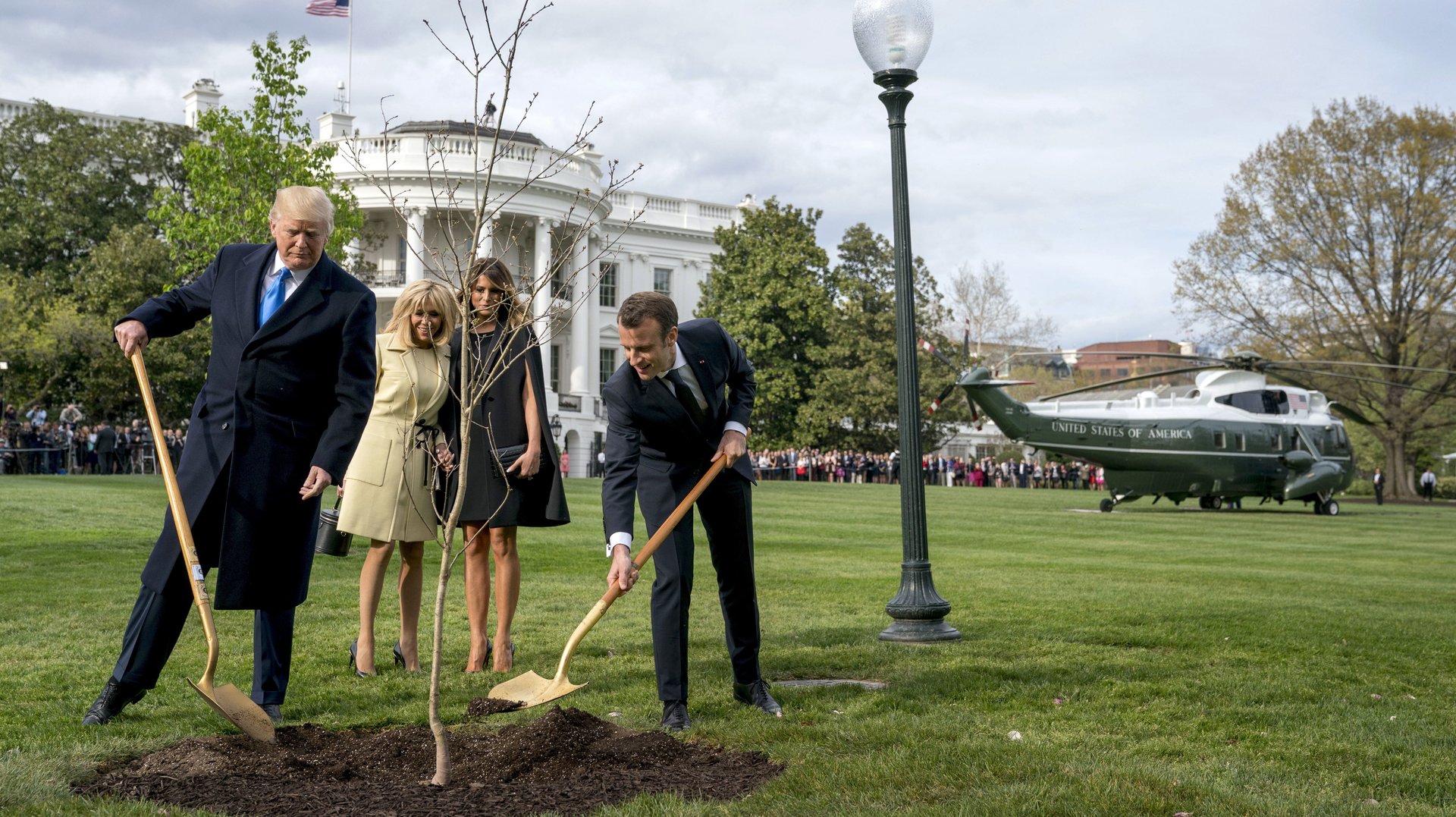The oak sapling the French president gave to Trump is dead, like their friendship
“To exist as a nation, to prosper as a state, to live as a people, we must have trees,” US president Theodore Roosevelt once said.


“To exist as a nation, to prosper as a state, to live as a people, we must have trees,” US president Theodore Roosevelt once said.
It is perhaps with this sentiment in mind that, in April 2018, French President Emmanuel Macron and his wife, Brigitte, together with Donald and Melania Trump, planted an oak sapling in the garden of the White House. Like the Statue of Liberty, it was a gift from France to America: Macron thoughtfully uprooted it from the site of a World War I battle in which many Americans lost their lives.
It was a perfect gift—a budding tree to mark a budding friendship, one that had overcome Macron’s attempts to steal Trump’s talent and the American president’s questionable compliments of Macron’s wife. Oak trees can live hundreds of years—just like the friendship between France and the United States.
Well, time passed and seasons changed. And so did the relationship between Macron and Trump. What was once considered a “bromance” has since turned sour. The two leaders have recently exchanged pointed remarks on nationalism, international relations, and the role of the United States in the world.
And then, just as the pair met again on the anniversary of D-Day, that great symbol of their former friendship withered and died. The sapling didn’t survive its required quarantine, and never made it back to the White House lawn.
It was sad news. Oak trees are hearty and resilient, and live hundreds of years. “An old adage says that they will grow for 300 years, hold for 300 years, and die for 300 years,” said Roderick Cameron, curator of the Grigadale Arboretum in Argentina and a member of the International Oak Society. European oaks live even longer than American ones, he added, especially the species Macron presented Trump.
So, what went wrong? Guy Sternberg, another oak expert and member of the International Oak Society, said that between the origin of the tree, the endless transportation, and the time of year it was planted, “the tree never stood a chance.”
Don’t get a tree from the wild
Macron took the tree from the site of a battle. So it was removed from the wild. While thoughtful, it was not great for the tree’s chance of survival. A tree grown in a nursery undergoes root training that makes it easier to transport, whereas one taken from the wild will have roots extending far away from the plant itself. A sapling of the size given to the White House, for instance, would have roots that are over a meter long. It’s almost impossible to dig them out without causing damage.
Don’t plant your tree when the weather is nice
The nice spring day when Macron visited the White House made for good photos, but spring is actually the worst time to plant a tree. “You never ever try to transplant [a tree] in April or May,” Sternberg said. Toward the end of winter, a tree comes out of hibernation and starts growing roots. That’s a better time to plant it.
As soon a the temperature goes up, and the tree starts developing new branches and buds, moving it is traumatic. Of course, Macron didn’t have the chance to wait. The state visit was scheduled for late April. Still, Sternberg said that “no one would move a tree that time of the year if they had the choice.”
Don’t fake-plant a tree
One transportation is hard on a tree; two are just excessive. The White House tree was dug out after the ceremony in the lawn and moved into quarantine. But planting it for a photo opportunity and then removing it again from the soil is too much stress for an already distressed plant.
Get expert advice
It’s hard to imagine having access to better expertise than the Elysée and the White House combined, which means the sad fate of the friendship tree was likely expected even by those who did their best to keep it alive.
“I don’t think anyone expected it to survive,” Sternberg said. Still, it’s important to ask for help from professionals—even for trees that are coming from a nursery, and are planted at the right time of the year. There is a strategy to ensure the roots don’t circle around themselves, for instance, which ends up suffocating the plant. Sternberg suggested relying on support from experts at universities or forest departments.
Don’t give up
The saying “strong as an oak” exists for a reason: You can keep your tree thriving pretty easily. Even if the sapling looks dry and it’s lost all its leaves, Cameron said, it’s worth scratching the bark to see if there is green underneath. It takes weeks for a sapling to dry out completely, so there’s a chance the core will still be green, and new branches can sprout again.
That wasn’t the case, sadly, for the Trump and Macron’s friendship tree.